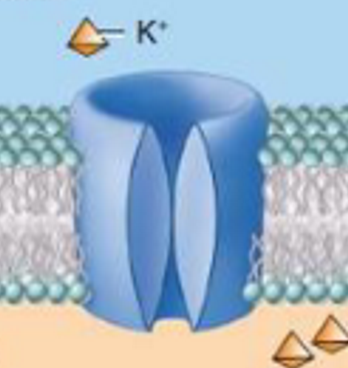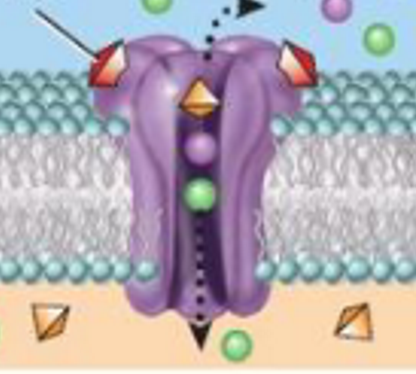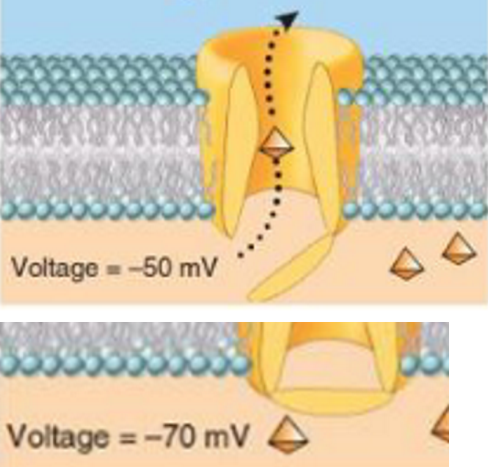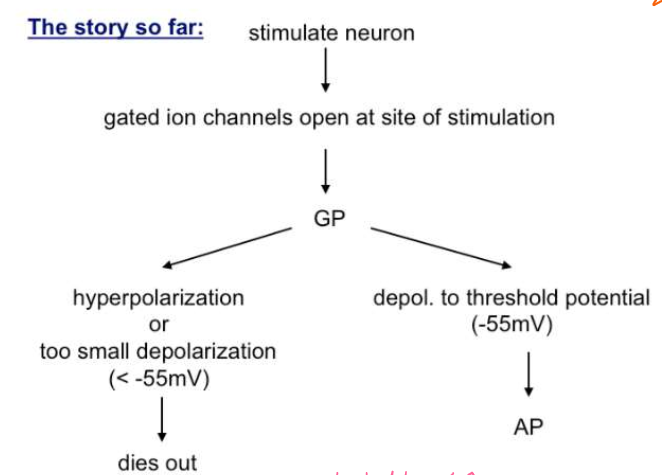3. Nervous System 1 (pt. 1)
electrochemical properties of cells, graded potentials, graded to AP
-
What happens when a neuron is stimulated/excited?
an electrical impulse (signal) may be generated and propagated along the axon (called a nerve impulse)
-
What is an electrochemical gradient?
- differences in the concentration of ions and molecules between a cell's intracellular and extracellular fluids
-
What can an electrochemical gradient be used for?
- signaling by some cells (especially nerve and muscle cells).
- gives cells their electrical properties
-
What are electrochemical gradients caused by (what causes the conditions that are an electrochemical gradient)?
- ionic concentration differences across membrane (gradients)
- permeability of cell membrane to ions
-
What are the important ions in regards to electrochemical gradients?
o K+, Na+, Cl-, Ca++
o large negatively charged organic ions (org-) – are non-diffusable proteins
-
What are the levels on Na+ and K+ in ECF and ICF? How is this maintained?
- [Na+] is high in the ECF (low in ICF)
- [K+] is low in the ECF of the cell and high in the ICF
- maintained by the activity of the Na+/K+- ATPase (pump) in the cell membrane
-
What are the tendencies of Cl-? (regards to ECF and ICF)
- Cl- is repelled by org- (large, negatively charged organic ions) so has a higher concentration in the ECF than the ICF
-
What are the tendencies of Ca2+? (regards to ECF and ICF)
- [Ca2+] is higher in the ECF due to various transporters in the cell membrane and the endoplasmic reticulum membranes (i.e. the smooth endoplasmic reticulum is a storage area for calcium ions, that keeps Ca++ out of the cytosol)
-
What are the tendencies of negatively charged large organic ions? (regards to ECF and ICF)
- they stay inside the cell (non-diffusible proteins)
-
What determines the permeability of cell membranes to ions?
- ion channels: ions diffuse through them and down concentration gradients
-
What are the two types of ion channel types?
non-gated channels (leakage channels) and gated channels
-
What are the characteristics of non-gated channels? What about in relation to K+?
- they are always open
- more K+ than Na+ non-gated channels, therefore the cell membrane is more permeable to K+ at rest (no stimulus)
- these channels (especially K+ channels) are important in establishing the resting membrane potential (RMP)
-
What are the characteristics of gated channels? What are the types?
- not involved at rest, open in response to stimuli
- types: voltage gates, chemical/ligand gates, thermal gates, and mechanical gates
-

What kind of channel is this?
Closed K+ leakage channel
-

What kind of channel is this?
Open ligand/chemical gated channel
-

What kind of channel is this?
Voltage-gated channel
-
What is membrane potential? How is it created?
- the difference in electrical charge between the inside and outside of a cell
- created by the movement of ions, which are charged particles, across the cell membrane
-
How is membrane potential measured and what is it essential in?
- measured in millivolts (mV)
- essential for processes like nerve signaling, muscle contraction, and maintaining homeostasis
-
What is resting membrane potential?
- the charge difference (potential difference) just across the cell membrane in of a resting (not stimulated) cell
- approximately -70 mV (inside of cell is more negative)
-
What are the factors that establish the RMP?
- Na+/K+-ATPase (Na+/K+ pump) - not a channel
- org- (large negatively charged organic ions) inside cell – can’t cross membrane
- K+ is the major determinant of RMP because there are more non-gated K+ channels than Na+ (so more permeable to K+ than Na+ at rest)
-
What role do Na+/K+-ATPase (Na+/K+ pumps) play in the resting membrane potential?
- contributes a little (a few mV) to RMP (pumping more positive ions out than in)
- maintains concentration gradients of Na+ and K+
-
What do Na+/K+-ATPase (Na+/K+ pumps) do to play their role in RMP?
- breaks down 1 ATP and uses energy to pump 3 Na+ out and 2 K+ in
- active transport as both ions are pumped against their concentration gradients
-
What is the net movement of ions at the RMP?
- RMP is - 70mV
- net movement is 0 as Na+ (pos charge) moving in is equal to the K+ (pos charge) moving out
-
What happens to the cell when the inside becomes more negative?
- K+ diffusion slows as inside becomes increasingly negative
- Na+ diffusion into cell increases due to increasing attraction to negatively charged cell interior
- until -70 mV is reached, the amount of K+ moving out of the cell is greater than the amount of Na+ moving in (greater K+ permeability)
-
What happens when the inside of a cell is at -70mV again after being more negative?
- once at -70mV, the amount of K+ moving out equals the amount of Na+ moving in
- electrical gradient increases the rate of Na+ entry into the cell, and slows down the K+ exiting cell (creating RMP, 0 net movement of charges)
-
What cells are electrically excitable? What are they capable of in response to stimuli?
- only muscle and nerve cells
- capable of producing departures from RMP in response to stimuli (= changes in the external or internal environment)
-
What happens when a neuron is stimulated?
- gated ion channels open
- MP changes, producing a graded potential.
- If the threshold potential is reached (from GP) it triggers an action potential
-
What is a graded potential?
a small change in RMP caused by a stimulus, usually on dendrite or cell body by opening gated channels (changing membrane permeability)
-
What are the two kinds of polarization for a GP?
- more positive than RMP = depolarization e.g. -70 mV to -65 mV (closer to zero)
- more negative than RMP = hyperpolarization e.g. -70 mV to -75 mV
-
What kind of signals are graded potentials (lifespan)?
- short distance signals - die away quickly (short lived)
-
What is the ion movement caused by GP?
- charges that enter the cell move towards adjacent areas of opposite charge and causes depolarization or hyperpolarization on adjacent membrane
- Ion movement = current flow
-
What determines magnitude or distance travelled by GP?
- varies directly with the strength of the stimulus
- a larger stimulus leads to a larger graded potential that travels further
-
What happens after a graded potential?
o repolarization = return to RMP after depolarization or hyperpolarization
-
What causes an action potential?
- A large enough GP (caused by stimuli) or a sum of GPs, must be depolarization (to -55mV)
- steps: stimuli, GP reach threshold, AP
-
What happens when a neuron is stimulated? (in terms of GP)


